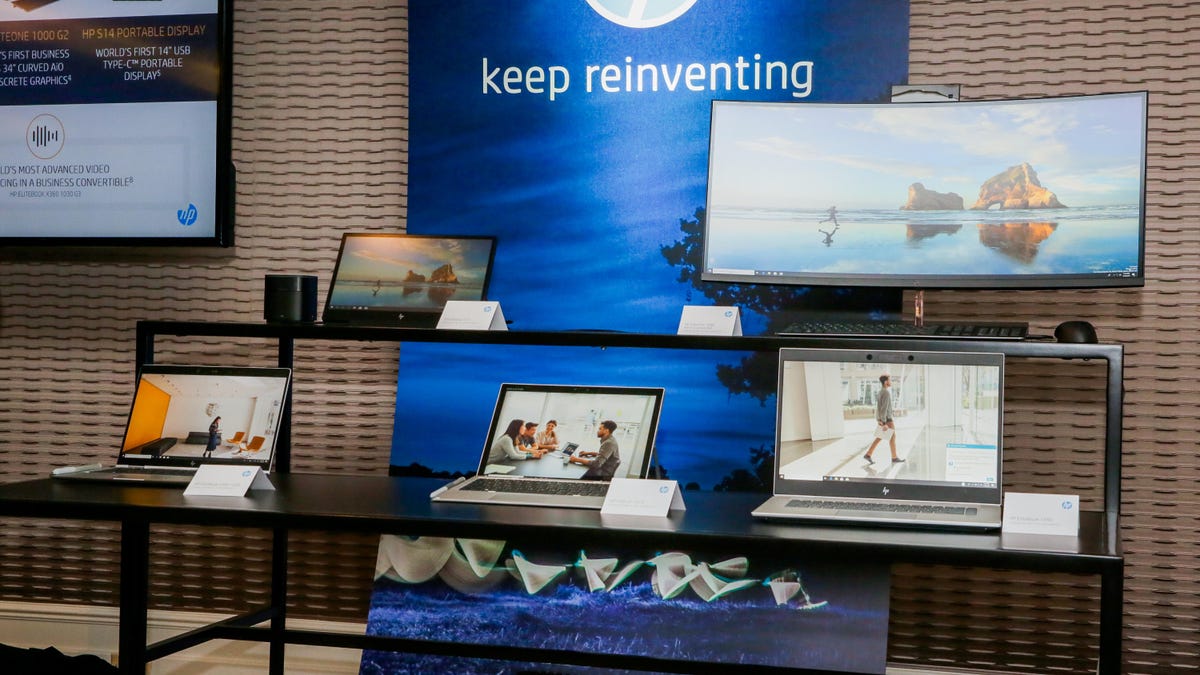
HP's Elites
Summer updates to the line include the three laptops -- 1030 G3, 1013 x2 G3 and the new 15-inch 1050 G1 -- the S14 portable display and the EliteOne 1000 G2.
HP EliteBook 1050 G1
The only addition to the line is the 15-inch 1050 G2; the flagship thin-and-light business line didn't have a model for people who need more screen. If the design looks familiar, that's because it's extremely similar to the Spectre x360 announced earlier this year.
HP EliteBook 1050 connections
On the left side there are two USB Type-A ports.
HP EliteBook 1050 connections
On the right side are two USB-C/Thunderbolt connections and an HDMI connection, plus a full-size SD card slot.
HP EliteBook 1050 power
HP fits a full set of connectors in plus vents on both sides. The extra vents are necessary because the 1050 incorporates an Nvidia GTX 1050 GPU and up to 32GB RAM
HP EliteBook 1050 keyboard
Oddly, the Spectre 15-inch model has a much bigger keyboard, with a full numeric keypad on the right side. I'd expect a business system to have that, too. The 1050's speaker grille and location are the same.
HP EliteBook 1050 SureView 2
HP has updated its privacy screen feature, available on select displays; it's still not available in 4K.
HP EliteBook 1050 webcam shutter
HP introduced its webcam shutter -- a switch that blocks the camera when not in use -- to its EliteBook line earlier this year.
HP EliteBook 1050 webcam shutter close up
HP EliteBook 1050
As expected from a business notebook, it includes a fingerprint sensor for secure login.
HP EliteBook 1050 design
The 1050 takes a design tip from HP's latest ZBook mobile workstations with chamfered edges near the hinges.
HP EliteBook x360 1030 G3
On the outside, the G3 version of the EliteBook x360 doesn't look much different than the G2 version we reviewed earlier this year.
HP EliteBook x360 1030 updates
Updates to this convertible include eighth-generation Core i processors; the brighter displays that HP rolled out across the entire line; faster Cat 9 LTE wireless support; and a proximity alert for the Active Pen, which notifies you when you leave its geofenced range.
HP EliteBook x2 1013
The x2 received some design tweaks this go-round, including squared edges and thinner display bezels, which really does give it a sleeker look and allows HP to up the screen size from 12.3 to 13 inches.
HP Elitebook x2 1013 display
The x2 gets the higher-brightness display options that have been introduced across the entire EliteBook line, intended to help with outdoor viewing. There's also a SureView privacy screen option.
HP Elitebook x2 1013 connections
HP added two more USB-C ports for a total of three, one of which supports the DisplayPort alternate mode in addition to Thunderbolt 3.
HP EliteDisplay S14
This rather old display finally gets the dust brushed off with a more modern look -- squared edges and thinner bezels help make it a little smaller -- and support for USB-C.
HP EliteDisplay S14 resolution
Now the resolution goes up to a standard 1,920x1,080 so you can better use it to watch HD content.
HP EliteDisplay S14 size
It's also smaller and lighter than the older model.
HP EliteDisplay S14 power
However, it consumes more power -- 5 watts typically compared with 4 watts for the earlier model, and 15 watts maximum, compared to 7 watts. That doesn't matter if you're plugged in, but it might when you're working on the road. It's brighter than before, too, but still a disappointing 250 nits.
HP EliteDisplay S14 back
The view for other people looks nice as well.
HP EliteDisplay S14 stand
The stand remains basically the same, and looks a lot like Apple's iPad Smart Cover.
HP EliteOne 1000 AiO G2
The business version of its Envy model, the EliteOne can now be configured with a discrete AMD Radeon RX 560 GPU.
HP EliteOne 1000 AiO G2
Instead of the charging pad on the base of the Envy, though, you get the collaboration controls and it retains the up-driving speakers of the previous models. And you can still swap bases and displays for improved upgradeability and hand-me-down-ability.
HP EliteOne 1000 AiO G2 popup webcam
It retains the popup webcam that you can push down when you want privacy or when it's not in use.
HP EliteOne 1000 AiO G2 models
In addition to the model with the 34-inch curved display, it comes in more traditional 24- and 27-inch flat screens.
HP EliteOne 1000 AiO 27-inch 4K UHD Display
You can still configure the 27-inch model with a 4K display.
HP EliteBook x360 1030
Enjoy the rest of the photos in caption-free silence.



